2015 TOYOTA TACOMA check engine
[x] Cancel search: check enginePage 477 of 590
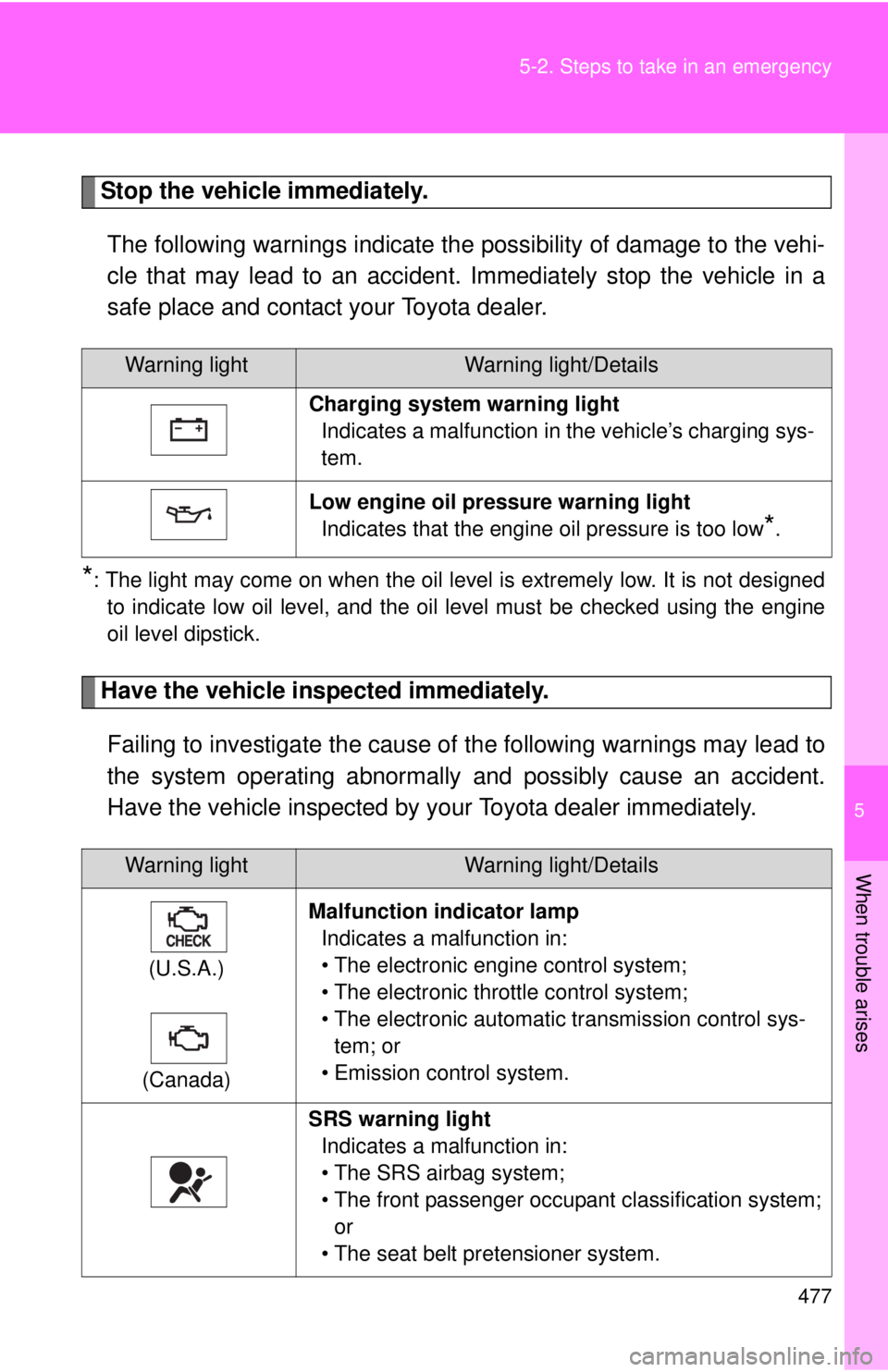
5
When trouble arises
477
5-2. Steps to take in an emergency
Stop the vehicle immediately.
The following warnings indicate the possibility of damage to the vehi-
cle that may lead to an accident. Immediately stop the vehicle in a
safe place and contact your Toyota dealer.
*: The light may come on when the oil level is extremely low. It is not designed to indicate low oil level, and the oil level must be checked using the engine
oil level dipstick.
Have the vehicle inspected immediately.
Failing to investigate the cause of the following warnings may lead to
the system operating abnormally and possibly cause an accident.
Have the vehicle inspected by your Toyota dealer immediately.
Warning lightWarning light/Details
Charging system warning light Indicates a malfunction in the vehicle’s charging sys-
tem.
Low engine oil pressure warning light Indicates that the engine oil pressure is too low
*.
Warning lightWarning light/Details
(U.S.A.)
(Canada) Malfunction indicator lamp
Indicates a malfunction in:
• The electronic engine control system;
• The electronic throttle control system;
• The electronic automatic transmission control sys-tem; or
• Emission control system.
SRS warning light Indicates a malfunction in:
• The SRS airbag system;
• The front passenger occupant classification system; or
• The seat belt pretensioner system.
Page 482 of 590

482 5-2. Steps to take in an emergency
■Key reminder buzzer
The buzzer indicates that the key has not been removed (with the engine
switch in the ACC or LOCK position and the driver’s door opened).
■ If the malfunction indicator lamp comes on while driving
First check the following:
● Is your vehicle low on gas?
If it is, refuel the vehicle immediately.
● Is the fuel tank cap loose?
If it is, tighten it securely.
The light will go off after taking several driving trips.
If the light does not go off even after several trips, contact your Toyota dealer
as soon as possible.
■ Front passenger detect ion sensor and passenger seat belt reminder
If luggage or other load is placed on the front passenger seat, depending on
its weight, the reminder light to flash and buzzer to sound.
■
When the tire pressure warning light comes on
Check the tire inflation pressure and adjust to the appropriate level.
Pushing the tire pressure warning reset switch does not turn off the tire
pressure warning light.
■The tire pressure warning light ma y turn on due to natural causes
The tire pressure warning light may turn on due to natural causes such
as natural air leaks or tire inflation pressure changes caused by temper-
ature. In this case, adjusting the ti re inflation pressure will turn off the
warning light (after a few minutes).
■When a tire is replaced with a spare tire
The temporary spare tire is not equipped with the tire pressure warning
valve and transmitter. If a tire goes flat, the tire pressure warning light will
not turn off even though the flat tire is replaced with the temporary spare
tire. Replace the temporary spare tire with the repaired tire and adjust
the proper tire inflatio n pressure. The tire pres sure warning light will turn
off after a few minutes.
Page 483 of 590

5
When trouble arises
483
5-2. Steps to take in an emergency
■If the tire pressure warning system is inoperative
The tire pressure warning system will be disabled in the following condi-
tions:
(When the condition be
comes normal, the system will work properly.)
●If tires not equipped with tire pressure warning valves and transmit-
ters are used.
●If the ID code on the tire pressure warning valves and transmitters is
not registered in the tire pressure warning computer.
●If the tire inflation pressure is 73 psi (500 kPa, 5.1 kgf/cm2 or bar) or
higher.
The tire pressure warning system may be disabled in the following condi-
tions:
(When the condition be comes normal, the system will work properly.)
●If electronic devices or facilities using similar radio wave frequencies
are nearby.
●If a radio set at similar frequencies is in use in the vehicle.
●If a window tint that affects the radio wave signals is installed.
●If there is a lot of snow or ice on the vehicle, in particular around the
wheels or wheel housings.
●If non-genuine Toyota wheels are used. (Even if you use Toyota
wheels, the tire pressu re warning system may not work properly with
some types of tires.)
●If tire chains are used.
■If the tire pressure warning light frequently comes on after blinking
for 1 minute
If the tire pressure warning light frequently comes on after blinking for 1
minute when the engine switch is turned to the ON position, have it
checked by your Toyota dealer.
■ Customization that can be co nfigured at Toyota dealer
The vehicle speed linked seat belt reminder buzzer can be disabled.
(Customizable features P. 551)
Page 497 of 590
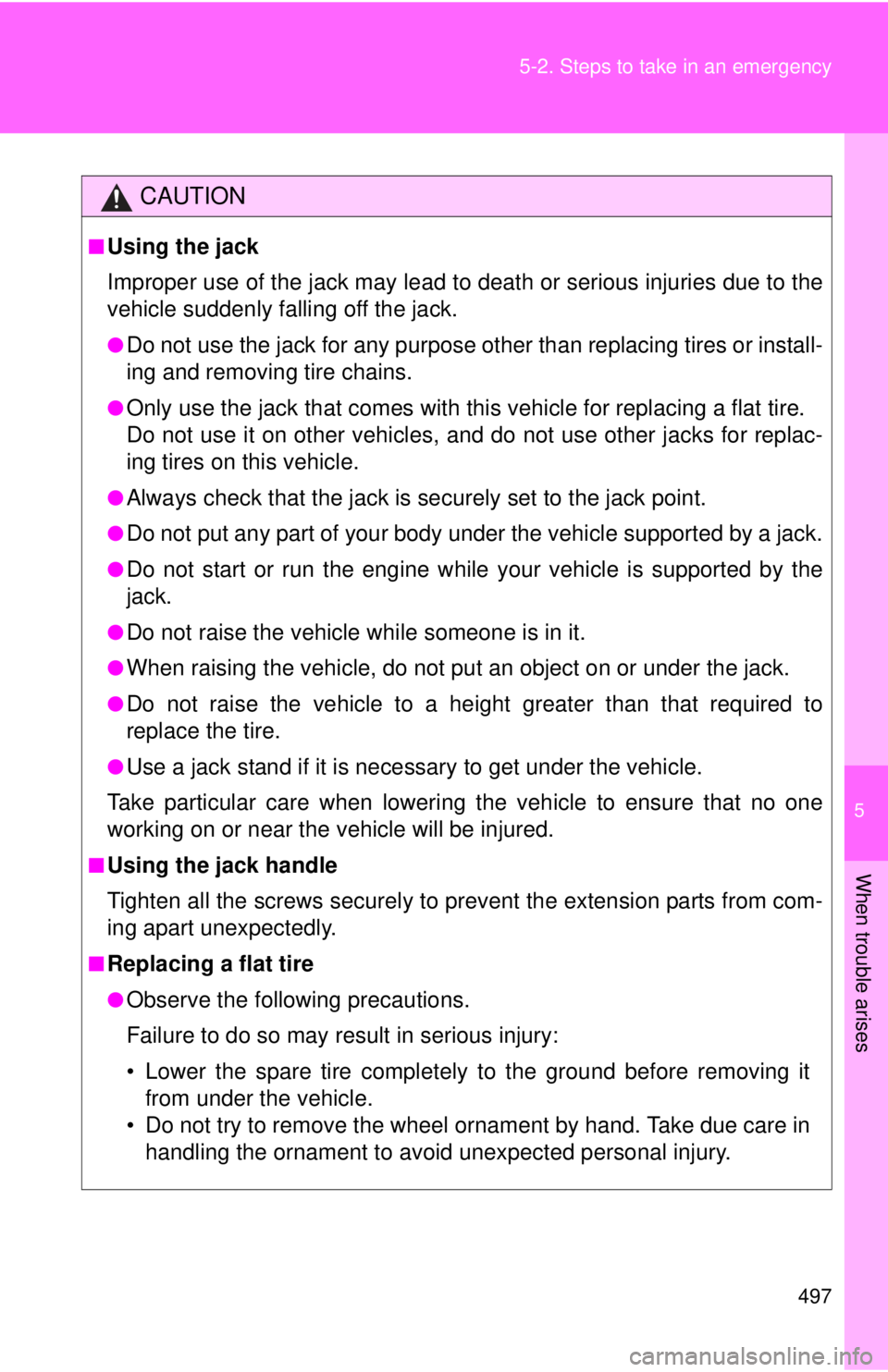
5
When trouble arises
497
5-2. Steps to take in an emergency
CAUTION
■Using the jack
Improper use of the jack may lead to death or serious injuries due to the
vehicle suddenly falling off the jack.
●Do not use the jack for any purpose other than replacing tires or install-
ing and removing tire chains.
●Only use the jack that comes with this vehicle for replacing a flat tire.
Do not use it on other vehicles, an
d do not use other jacks for replac-
ing tires on this vehicle.
●Always check that the jack is securely set to the jack point.
●Do not put any part of your body under the vehicle supported by a jack.
●Do not start or run the engine while your vehicle is supported by the
jack.
●Do not raise the vehicle while someone is in it.
●When raising the vehicle, do not put an object on or under the jack.
●Do not raise the vehicle to a hei ght greater than that required to
replace the tire.
●Use a jack stand if it is necessary to get under the vehicle.
Take particular care when lowering the vehicle to ensure that no one
working on or near the vehicle will be injured.
■Using the jack handle
Tighten all the screws securely to prevent the extension parts from com-
ing apart unexpectedly.
■Replacing a flat tire
●Observe the following precautions.
Failure to do so may resu lt in serious injury:
• Lower the spare tire completely to the ground before removing it from under the vehicle.
• Do not try to remove the wheel ornament by hand. Take due care in handling the ornament to avoid unexpected personal injury.
Page 505 of 590
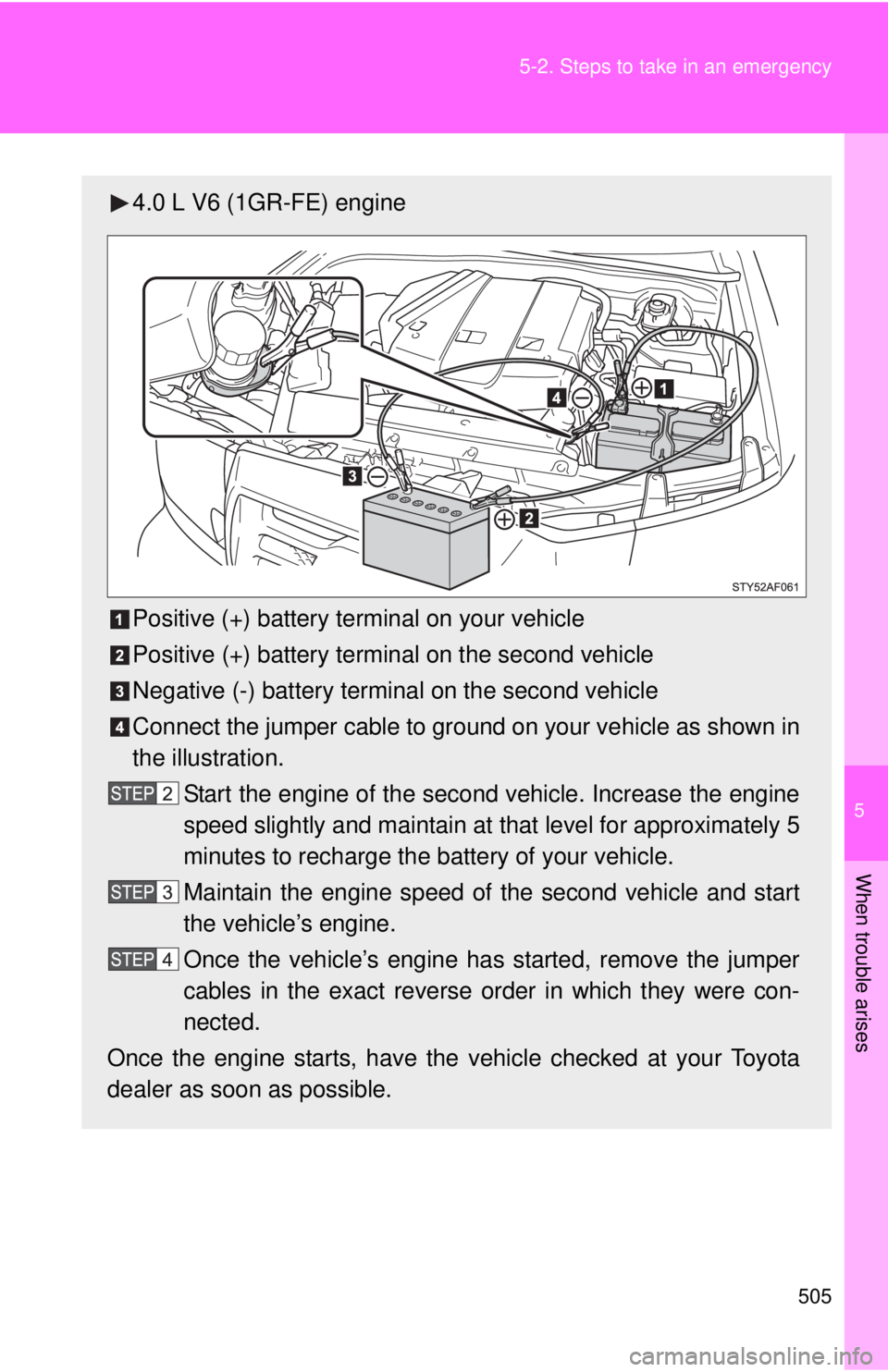
5
When trouble arises
505
5-2. Steps to take in an emergency
4.0 L V6 (1GR-FE) engine
Positive (+) battery terminal on your vehicle
Positive (+) battery terminal on the second vehicle
Negative (-) battery terminal on the second vehicle
Connect the jumper cable to ground on your vehicle as shown in
the illustration.
Start the engine of the second vehicle. Increase the engine
speed slightly and maintain at that level for approximately 5
minutes to recharge the battery of your vehicle.
Maintain the engine speed of the second vehicle and start
the vehicle’s engine.
Once the vehicle’s engine has started, remove the jumper
cables in the exact reverse order in which they were con-
nected.
Once the engine starts, have the vehicle checked at your Toyota
dealer as soon as possible.
Page 509 of 590
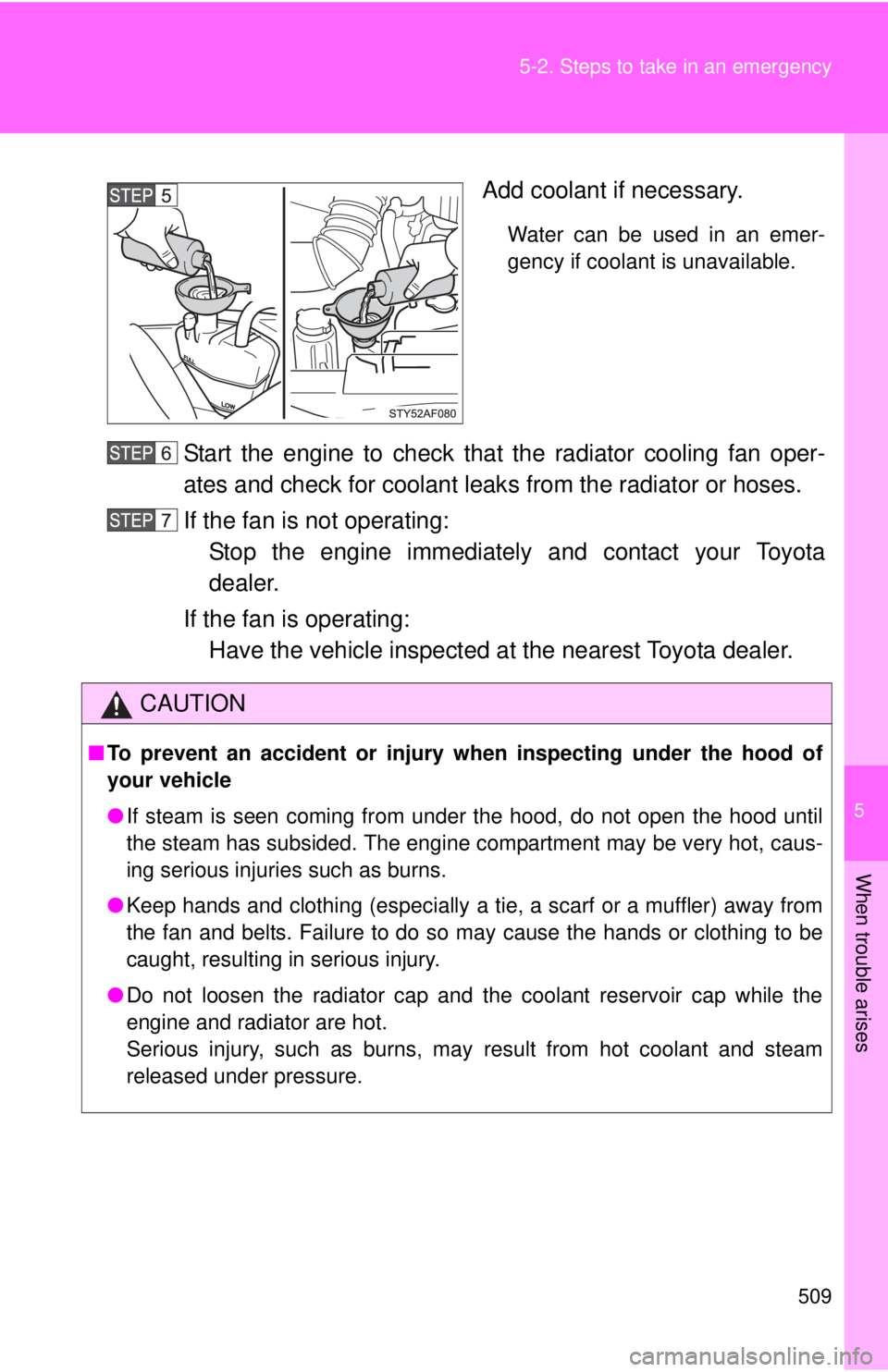
5
When trouble arises
509
5-2. Steps to take in an emergency
Add coolant if necessary.
Water can be used in an emer-
gency if coolant is unavailable.
Start the engine to check that the radiator cooling fan oper-
ates and check for coolant leak
s from the radiator or hoses.
If the fan is not operating: Stop the engine immediately and contact your Toyota
dealer.
If the fan is operating: Have the vehicle inspected at the nearest Toyota dealer.
CAUTION
■To prevent an accident or injury when inspecting under the hood of
your vehicle
●If steam is seen coming from under the hood, do not open the hood until
the steam has subsided. The engine compartment may be very hot, caus-
ing serious injuries such as burns.
● Keep hands and clothing (especially a tie, a scarf or a muffler) away from
the fan and belts. Failure to do so may cause the hands or clothing to be
caught, resulting in serious injury.
● Do not loosen the radiator cap and the coolant reservoir cap while the
engine and radiator are hot.
Serious injury, such as burns, may result from hot coolant and steam
released under pressure.
Page 526 of 590
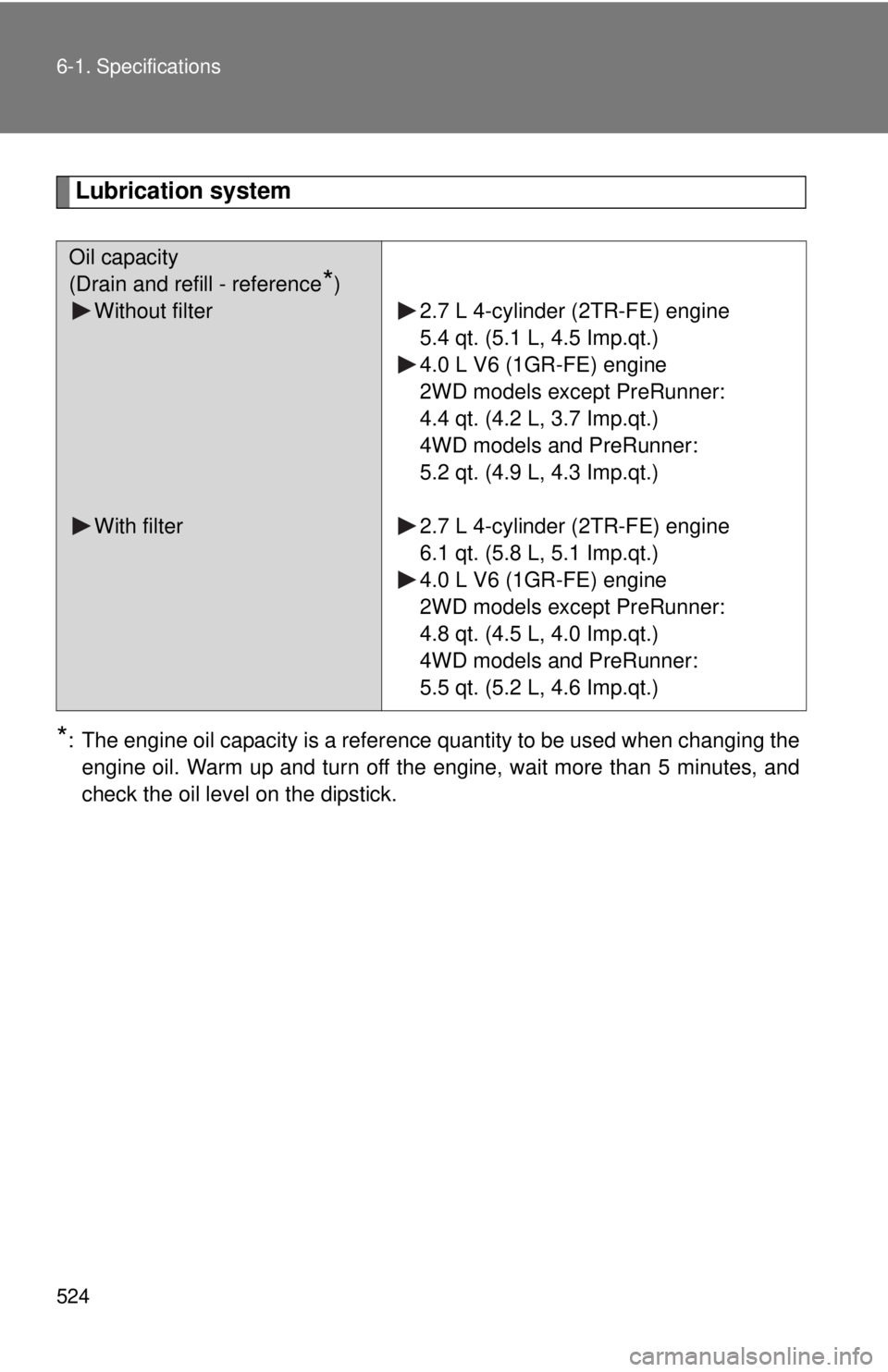
524 6-1. Specifications
Lubrication system
*: The engine oil capacity is a reference quantity to be used when changing theengine oil. Warm up and turn off the engine, wait more than 5 minutes, and
check the oil level on the dipstick.
Oil capacity
(Drain and refill - reference
*)
Without filter
With filter 2.7 L 4-cylinder (2TR-FE) engine
5.4 qt. (5.1 L, 4.5 Imp.qt.)
4.0 L V6 (1GR-FE) engine
2WD models except PreRunner:
4.4 qt. (4.2 L, 3.7 Imp.qt.)
4WD models and PreRunner:
5.2 qt. (4.9 L, 4.3 Imp.qt.)
2.7 L 4-cylinder (2TR-FE) engine
6.1 qt. (5.8 L, 5.1 Imp.qt.)
4.0 L V6 (1GR-FE) engine
2WD models except PreRunner:
4.8 qt. (4.5 L, 4.0 Imp.qt.)
4WD models and PreRunner:
5.5 qt. (5.2 L, 4.6 Imp.qt.)
Page 580 of 590

578 Alphabetical index
Daytime running light system .................................... 154
Deck Auxiliary boxes ...................... 365
Deck ...................................... 364
Deck hooks ........................... 366
Deck rails .............................. 202
Tie-down cleats ..................... 367
Detachable pole antenna......... 335
Dimension................................. 516
Dinghy towing .......................... 233
Do-it-yourself main tenance..... 400
Doors Access doors...........................39
Door glasses ...........................71
Door lock ...........................32, 35
Open door warning light ........ 479
Side doors ...............................35
Side mirrors .............................68
Downhill Assist Control
System .................................... 188
Driver’s seat belt reminder light ......................................... 479
Driver’s seat belt reminder warning buzzer ...................... 479
Driving
Break-in tips .......................... 122
Correct posture .......................80
Driving assist systems........... 191
Procedures ............................ 120
Winter driving tips.................. 209
Emergency, in case of Blown fuse............................. 444
If the engine will not start ...... 501
If the shift lever cannot be shifted from P...................... 502
If the vehicle battery is discharged .......................... 504
If the warning buzzer
sounds ................................ 476
If the warning light turns on ... 476 If you have a flat tire ............. 486
If you lose your keys ............. 503
If you think something is
wrong .................................. 474
If the vehicle becomes
stuck ................................... 511
If your vehicle has to be stopped in an emergency ... 513
If your vehicle needs to be towed .................................. 467
If your vehicle overheats ....... 508
Emergency flashers Switch ................................... 466
Engine
Compartment ........................ 406
Engine switch ........................ 131
Exhaust gas .......................... 127
Hood ..................................... 404
How to start the engine ......... 131
Identification number............. 521
If the engine will not start ...... 501
Ignition switch ....................... 131
Immobilizer system ................. 77
Overheating .......................... 508
Warning light ......................... 477
Engine coolant
Capacity ................................ 527
Checking ............................... 412
Preparing and checking before winter ....................... 209
Temperature gauge .............. 145
Engine coolan t temperature
gauge ...................................... 145
Engine immobilizer system ...... 77
Engine oil Capacity ................................ 524
Checking ............................... 408
Preparing and checking before winter ....................... 209
Warning light ......................... 477
Engine switch........................... 131
Event data recorder ................... 24D
E